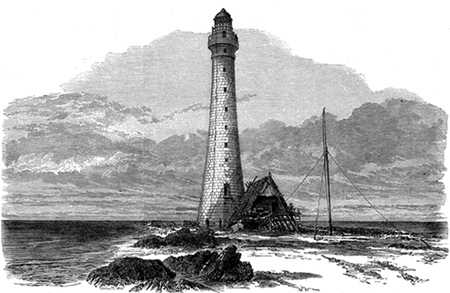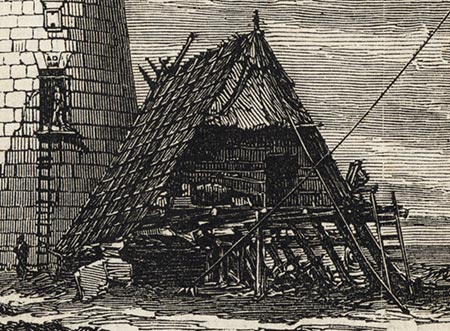Marking time in July 2010
Alguada Reef Lighthouse
So remote is this lighthouse tower, on a wave-swept rocky reef off the coast of Myanmar, that a google image search found no photographs of it. That remoteness, along with its beauty and its impressive height, prompts me to add this lighthouse to my must see list.

The Governor-General of India visited the reef in December 1853 and wrote a memo about the need for a lighthouse:
Passing down the coast of Arracan we found the weather so fine as to admit of our passing close to the Alguada Reef.
This dangerous and dreaded line of rocks lies to the southward of Cape Negrais, at about ten miles below Diamond Island. It is very low, extends for probably a mile in length, and renders a divergence from the direct course between Calcutta and the Irrawaddy so necessary in common prudence, as to cause the loss of usually half a day in the passage. The Rear Admiral, before he left the station, urged upon the Government the expediency of erecting a Light House upon the reef, and the Government promised that the practicability of doing so should be examined as soon as an Officer could be spared for that purpose.
To-day I landed upon the reef. I found it composed of sandstone, laid by nature in parallel lines, and thrust up on edge with an inclination to the eastward, like all the rock and cliffs upon this eastern portion of the Bay of Bengal. It is covered with oyster and shell fish, and bears no appearance of vegetation, nor is there the smallest quantity of earth or even sand upon it.
Time did not admit of walking over the whole reef, but even close to the spot where we landed, there was a broad and comparatively level space of not less than twenty-five yards, which would give ample room for the foundation of any building that might be required. It is my impression that, if a site were selected towards the northern end of the main reef, where an outer reef protects it towards the East, and where the roll of the sea in the S. W. Monsoon will partly expend itself on the southern portion of the reef before it reaches the site, a Light House, either of stone or of iron, might be erected without any great difficulty or cost.
The Most Noble Marquis of Dalhousie underestimated the cost (over £100,000 by the time it was finished) and the degree of difficulty. An article in the journal Engineering reported in 1866:
There were many difficulties attending the erection of this edifice. In the first place, the works could only be carried on during the north-east monsoon, or from about the middle of November to the end of April, the force of the sea and violence of the waves during the south-west monsoon being such as entirely to prevent any work on the reef during their prevalence; consequently, at the end of each working season, all tools and temporary barracks erected for the shelter of the workpeople had to be removed. Besides this, the distance from which all materials and workpeople had to be collected caused no small hindrance to the speedy prosecution of the works. On several occasions, also, even during the working seasons, the men had to leave the reef in the event of a severe storm.
The granite for the erection of the lighthouse was obtained partly from Callagouk, on the Tenasserim coast, a distance of over 200 miles, and partly from the Pulo Obin quarries, at Singapoor, 1200 miles from the reef. The labourers employed on the works were principally convicts from Moulmein, the quarrymen and masons were obtained from Hong Kong, and all the necessary machinery and tools from England. A depot was established on Diamond Harbour, 4½ miles off, for stores and materials, and barracks were erected there for the workpeople during the progress of the works. A signal tower, furnished with a telescope, signal mast, and a small reflector lamp, served to point out the course for boats coming from the reef, in the event of their being overtaken by night before leaving the lighthouse.
I am grateful to the Google books people for digitising a copy of Selections from the records of the Government of India (Public Works Department): No XXV: selection of papers regarding the construction of a light house on the Alguada Reef, published in Calcutta in 1858, but annoyed that they failed to scan the fold-out drawings in the back of the book.
